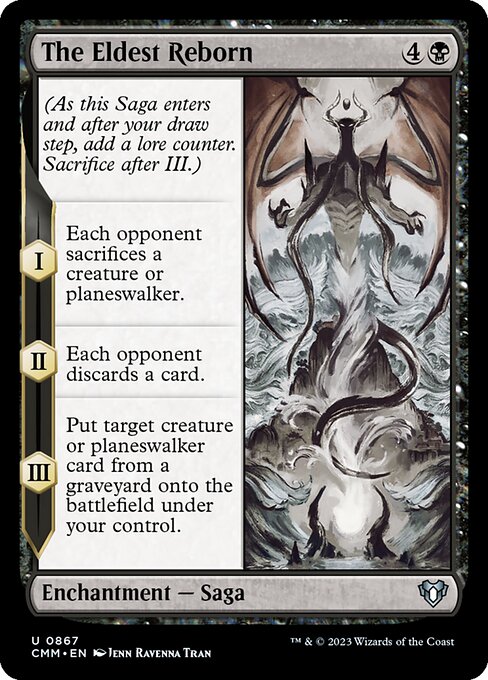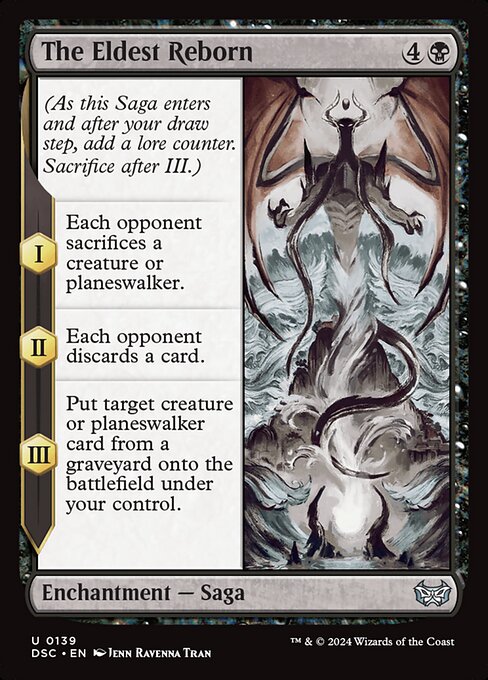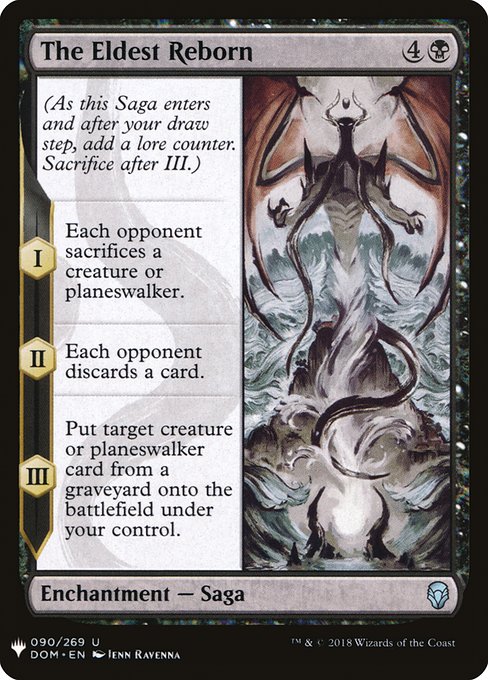La Renaissance de l'aîné
Enchantement : saga
(Au moment où cette saga arrive sur le champ de bataille et après votre étape de pioche, ajoutez un marqueur « sapience ». Sacrifiez après III.)
I — Chaque adversaire sacrifie une créature ou un planeswalker.
II — Chaque adversaire se défausse d'une carte.
III — Mettez sur le champ de bataille, sous votre contrôle, une carte de créature ou de planeswalker ciblée depuis un cimetière.
I — Chaque adversaire sacrifie une créature ou un planeswalker.
II — Chaque adversaire se défausse d'une carte.
III — Mettez sur le champ de bataille, sous votre contrôle, une carte de créature ou de planeswalker ciblée depuis un cimetière.
standard
future
historic
gladiator
pioneer
explorer
modern
legacy
pauper
vintage
penny
commander
brawl
alchemy
paupercommander
duel
oldschool
premodern
Rulings
Once a chapter ability has triggered, the ability on the stack won’t be affected if the Saga gains or loses counters, or if it leaves the battlefield.
If counters are removed from a Saga, the appropriate chapter abilities will trigger again when the Saga receives lore counters. Removing lore counters won’t cause a previous chapter ability to trigger.
A chapter ability doesn’t trigger if a lore counter is put on a Saga that already had a number of lore counters greater than or equal to that chapter’s number. For example, the third lore counter put on a Saga causes the III chapter ability to trigger, but I and II won’t trigger again.
As a Saga enters the battlefield, its controller puts a lore counter on it. As your precombat main phase begins (immediately after your draw step), you put another lore counter on each Saga you control. Putting a lore counter on a Saga in either of these ways doesn’t use the stack.
Each symbol on the left of a Saga’s text box represents a chapter ability. A chapter ability is a triggered ability that triggers when a lore counter that is put on the Saga causes the number of lore counters on the Saga to become equal to or greater than the ability’s chapter number. Chapter abilities are put onto the stack and may be responded to.
Once the number of lore counters on a Saga is greater than or equal to the greatest number among its chapter abilities—in the Dominaria set, this is always three—the Saga’s controller sacrifices it as soon as its chapter ability has left the stack, most likely by resolving or being countered. This state-based action doesn’t use the stack.
If multiple chapter abilities trigger at the same time, their controller puts them on the stack in any order. If any of them require targets, those targets are chosen as you put the abilities on the stack, before any of those abilities resolve.
When the first chapter ability of The Eldest Reborn resolves, the next opponent in turn order (or, if it’s an opponent’s turn, that opponent) chooses a creature or planeswalker they control, then each other opponent in turn order (if any) does the same. All chosen permanents are then sacrificed at the same time. Players will know the choices made by earlier players when making their choices.
When the second chapter ability of The Eldest Reborn resolves, the next opponent in turn order (or, if it’s an opponent’s turn, that opponent) chooses a card in hand without revealing it, then each other opponent in turn order (if any) does the same. All chosen cards are then discarded at the same time.
In a multiplayer game, if a player leaves the game, all cards that player owns leave as well. If you leave the game, the permanent you control from The Eldest Reborn’s final chapter ability is exiled.
If counters are removed from a Saga, the appropriate chapter abilities will trigger again when the Saga receives lore counters. Removing lore counters won’t cause a previous chapter ability to trigger.
A chapter ability doesn’t trigger if a lore counter is put on a Saga that already had a number of lore counters greater than or equal to that chapter’s number. For example, the third lore counter put on a Saga causes the III chapter ability to trigger, but I and II won’t trigger again.
As a Saga enters the battlefield, its controller puts a lore counter on it. As your precombat main phase begins (immediately after your draw step), you put another lore counter on each Saga you control. Putting a lore counter on a Saga in either of these ways doesn’t use the stack.
Each symbol on the left of a Saga’s text box represents a chapter ability. A chapter ability is a triggered ability that triggers when a lore counter that is put on the Saga causes the number of lore counters on the Saga to become equal to or greater than the ability’s chapter number. Chapter abilities are put onto the stack and may be responded to.
Once the number of lore counters on a Saga is greater than or equal to the greatest number among its chapter abilities—in the Dominaria set, this is always three—the Saga’s controller sacrifices it as soon as its chapter ability has left the stack, most likely by resolving or being countered. This state-based action doesn’t use the stack.
If multiple chapter abilities trigger at the same time, their controller puts them on the stack in any order. If any of them require targets, those targets are chosen as you put the abilities on the stack, before any of those abilities resolve.
When the first chapter ability of The Eldest Reborn resolves, the next opponent in turn order (or, if it’s an opponent’s turn, that opponent) chooses a creature or planeswalker they control, then each other opponent in turn order (if any) does the same. All chosen permanents are then sacrificed at the same time. Players will know the choices made by earlier players when making their choices.
When the second chapter ability of The Eldest Reborn resolves, the next opponent in turn order (or, if it’s an opponent’s turn, that opponent) chooses a card in hand without revealing it, then each other opponent in turn order (if any) does the same. All chosen cards are then discarded at the same time.
In a multiplayer game, if a player leaves the game, all cards that player owns leave as well. If you leave the game, the permanent you control from The Eldest Reborn’s final chapter ability is exiled.
Rulings
Once a chapter ability has triggered, the ability on the stack won’t be affected if the Saga gains or loses counters, or if it leaves the battlefield.
If counters are removed from a Saga, the appropriate chapter abilities will trigger again when the Saga receives lore counters. Removing lore counters won’t cause a previous chapter ability to trigger.
A chapter ability doesn’t trigger if a lore counter is put on a Saga that already had a number of lore counters greater than or equal to that chapter’s number. For example, the third lore counter put on a Saga causes the III chapter ability to trigger, but I and II won’t trigger again.
As a Saga enters the battlefield, its controller puts a lore counter on it. As your precombat main phase begins (immediately after your draw step), you put another lore counter on each Saga you control. Putting a lore counter on a Saga in either of these ways doesn’t use the stack.
Each symbol on the left of a Saga’s text box represents a chapter ability. A chapter ability is a triggered ability that triggers when a lore counter that is put on the Saga causes the number of lore counters on the Saga to become equal to or greater than the ability’s chapter number. Chapter abilities are put onto the stack and may be responded to.
Once the number of lore counters on a Saga is greater than or equal to the greatest number among its chapter abilities—in the Dominaria set, this is always three—the Saga’s controller sacrifices it as soon as its chapter ability has left the stack, most likely by resolving or being countered. This state-based action doesn’t use the stack.
If multiple chapter abilities trigger at the same time, their controller puts them on the stack in any order. If any of them require targets, those targets are chosen as you put the abilities on the stack, before any of those abilities resolve.
When the first chapter ability of The Eldest Reborn resolves, the next opponent in turn order (or, if it’s an opponent’s turn, that opponent) chooses a creature or planeswalker they control, then each other opponent in turn order (if any) does the same. All chosen permanents are then sacrificed at the same time. Players will know the choices made by earlier players when making their choices.
When the second chapter ability of The Eldest Reborn resolves, the next opponent in turn order (or, if it’s an opponent’s turn, that opponent) chooses a card in hand without revealing it, then each other opponent in turn order (if any) does the same. All chosen cards are then discarded at the same time.
In a multiplayer game, if a player leaves the game, all cards that player owns leave as well. If you leave the game, the permanent you control from The Eldest Reborn’s final chapter ability is exiled.
If counters are removed from a Saga, the appropriate chapter abilities will trigger again when the Saga receives lore counters. Removing lore counters won’t cause a previous chapter ability to trigger.
A chapter ability doesn’t trigger if a lore counter is put on a Saga that already had a number of lore counters greater than or equal to that chapter’s number. For example, the third lore counter put on a Saga causes the III chapter ability to trigger, but I and II won’t trigger again.
As a Saga enters the battlefield, its controller puts a lore counter on it. As your precombat main phase begins (immediately after your draw step), you put another lore counter on each Saga you control. Putting a lore counter on a Saga in either of these ways doesn’t use the stack.
Each symbol on the left of a Saga’s text box represents a chapter ability. A chapter ability is a triggered ability that triggers when a lore counter that is put on the Saga causes the number of lore counters on the Saga to become equal to or greater than the ability’s chapter number. Chapter abilities are put onto the stack and may be responded to.
Once the number of lore counters on a Saga is greater than or equal to the greatest number among its chapter abilities—in the Dominaria set, this is always three—the Saga’s controller sacrifices it as soon as its chapter ability has left the stack, most likely by resolving or being countered. This state-based action doesn’t use the stack.
If multiple chapter abilities trigger at the same time, their controller puts them on the stack in any order. If any of them require targets, those targets are chosen as you put the abilities on the stack, before any of those abilities resolve.
When the first chapter ability of The Eldest Reborn resolves, the next opponent in turn order (or, if it’s an opponent’s turn, that opponent) chooses a creature or planeswalker they control, then each other opponent in turn order (if any) does the same. All chosen permanents are then sacrificed at the same time. Players will know the choices made by earlier players when making their choices.
When the second chapter ability of The Eldest Reborn resolves, the next opponent in turn order (or, if it’s an opponent’s turn, that opponent) chooses a card in hand without revealing it, then each other opponent in turn order (if any) does the same. All chosen cards are then discarded at the same time.
In a multiplayer game, if a player leaves the game, all cards that player owns leave as well. If you leave the game, the permanent you control from The Eldest Reborn’s final chapter ability is exiled.
Votre collection ? vos decks ?
Envie de gérer votre collection et/ou créer des decks ?
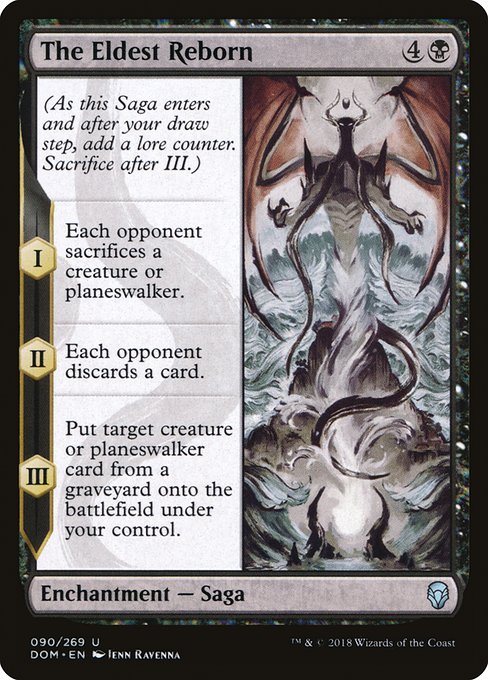

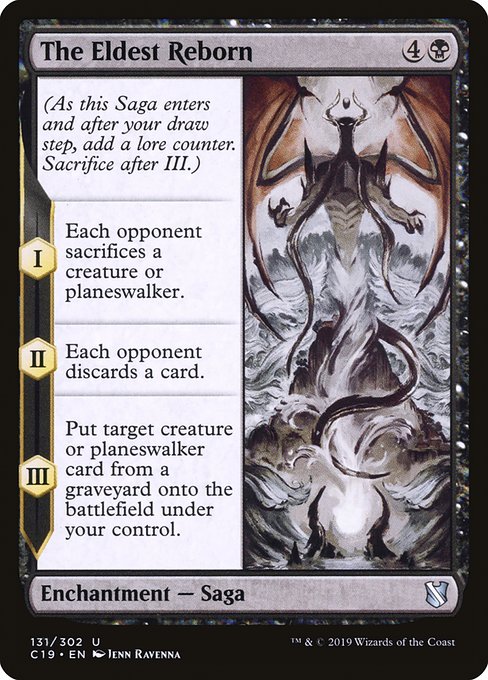
 0
0
 0.31€
0.31€
